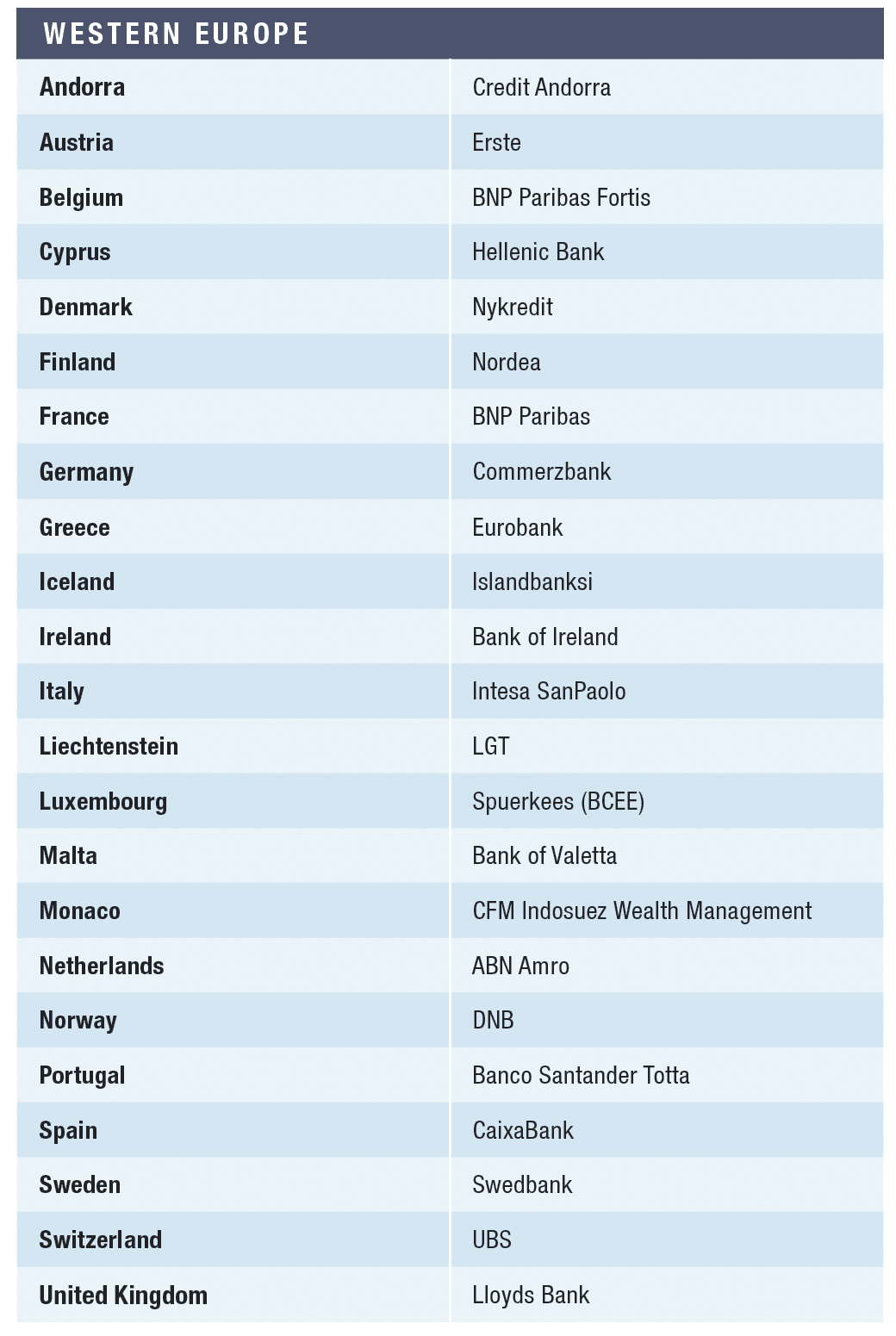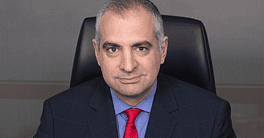Western European banks continue to boost profits in uncertain times.

Banks across Western Europe enjoyed higher levels of business activity during 2022, feeding through to enhanced profitability that allowed them to reward shareholders while at the same time maintaining strong capital buffers. In response to the post-Covid surge in demand for credit, most European banks expanded new lending to business and personal customers—especially mortgages—and as interest rates increased, so did bank lending margins. This tended to favor banks focused mainly on lending and deposit taking over those with larger market-trading and fee-generating wealth management arms, where declining asset values and outflows of customer funds dampened performance.
The digital transformation of Europe’s banks continued accelerating, with former laggards now in catch-up mode through either direct investment in the latest technologies or closer collaboration with fintechs. Digital leaders invested more in cutting-edge technologies such as artificial intelligence and quantum computing, and more banks moved their internal functions from legacy on-site systems to the cloud. The consolidation of the European system was limited to divestments of non-core activities, such as the sale by Belgian and Scandinavian banks of their operations in Ireland to two leading local banks—until, that is, the “shotgun wedding” of UBS and Credit Suisse, which may lead to the creation of Western Europe’s largest bank by assets.
CaixaBank is our Best Bank in Western Europe and our country winner in Spain, dramatically increasing its market share and boosting profits by 30% during 2022 while continuing to extend its leadership in sustainable financing and digital innovation.
Chairman José Ignacio Goirigolzarri told shareholders in March that “the bank has considerable strengths, a well-defined strategy and a differential banking model,” and, referring to the recent turmoil in global banking, pointed out that with its widespread deposit base, CaixaBank has a very different business model. “Our investments are extremely diversified because we serve all markets, from large corporations to households,” he said. “Our ratios are extremely robust in terms of liquidity and solvency.”
The acquisition of former rival Bankia, he added, has been “the largest integration ever undertaken in Spain’s banking sector” and reinforced CaixaBank’s leadership across most market segments. Further investment in innovative remote or digital channels and ongoing refinements to its state-of-the-art banking app raised the number of its digital clients to 11.2 million. And last year, the bank’s first climate report unveiled its strategy to reduce emission levels from its loan portfolio to one of the lowest in global banking by 2030.
Net interest and fee income rose by 14.7% and 8.7%, respectively; and despite higher provisions, attributable profit surged to nearly €3.2 billion (about $3.5 billion). The nonperforming loan (NPL) ratio fell to a record low of 2.7%. Enhanced efficiencies helped reduce costs by 5.6%. As a result, the return on tangible equity (ROTE) rose to 9.8% and the bank reinforced its liquidity and capital base. It ended the year with a common equity Tier-1 (CET1) ratio of 12.8% and its liquidity coverage ratio of 194%, almost twice the 100% minimum required.
Portugal’s best capitalized and most consistently profitable bank, Santander Totta, is once more our country winner, having raised underlying profit while simultaneously deleveraging through active portfolio sales. Total loans and advances to customers, amounting to €43.3 billion, were flat year-on-year. The bank grew its mortgage book by 5.5%, strengthening its 23.7% market share of new home loans. Operating income was flat; but an 11% cost reduction fed into underlying profits of €534 million, a 16% improvement on the previous year.
CEO Pedro Castro e Almeida declared, in commenting on the annual results, “Santander will maintain its policy of supporting people and businesses to prosper, supported by the comprehensive digital and commercial transformation that we have been carrying out, with clear benefits in the quality of service provided to our customers.”
Our Best Bank in Italy is Intesa Sanpaolo, which once more demonstrated its ability to generate solid profits through a diversified and resilient business model. Net income increased by almost a third to €5.5 billion—excluding the costs of Russia and Ukraine de-risking. During 2022, the group’s exposure to Russia was sharply reduced to below 0.3% of overall customer loans.
The bank’s gross income increased by 11.5% over the previous year. Operating margins improved by 7.4% as revenue rose and costs were contained to under 51% of income. As a result, Sanpaolo’s domestic Banca dei Territori division, which focuses on small and midsize enterprises (SMEs) and retail, raised net income by nearly half, to €471 million, thanks to higher margins and significantly lower operating costs and net provisions.
NPLs were reduced by 30% gross over the year, resulting in an NPL ratio of 2.3%. Intesa Sanpaolo maintains solid capital buffers well above regulatory requirements, its CET1 ratio standing at 13.8% by year end.
The position of our Best Bank in Switzerland, UBS, has been completely transformed. CEO Ralph Hamers presented a robust set of financial results for 2022, just under three months before stepping down in April. The takeover of former arch-rival Credit Suisse has further reinforced UBS’ dominant position in Swiss banking. However, it also brings unquantifiable financial liabilities and significant regulatory and organizational challenges that must be overcome before the two entities can be fully integrated.
Globally, UBS delivered a pretax profit of $9.6 billion in 2022, generating a return on Tier-1 equity of 17%. Within Switzerland, the bank extended $2.5 billion of new loans, while its wealth management arm attracted $9.1 billion of fee-generating assets.
The bank delivered good full-year results in a difficult macroeconomic and geopolitical environment, noted Hamers in his comments regarding the results. “Clients turned to us for stability and advice. … This resulted in $60 billion of net new fee-generating assets in 2022,” he said.
Since he stepped down, Hamers has been replaced as group CEO by veteran UBS leader Sergio P. Ermotti, who now faces the monumental task of integrating the parts of Credit Suisse that can be rescued and forging a new bank that will be, on current asset values, the largest in Europe.
This year’s Best Bank in France is BNP Paribas, on the strength of its being a digital leader among European banks while at the same time generating a sparkling financial performance at both national and group levels. Commercial and personal banking in France generated a €1.6 billion profit before tax in 2022, representing a 35.6% increase over the previous year. Net interest income rose 5% and revenues 6.6%, while costs were contained.
“Thanks to its solidity, the strength of its diversified and integrated model, and the expertise of our teams, BNP Paribas achieved a very good performance,” CEO Jean-Laurent Bonnafé said in commenting on fourth-quarter results. “This performance reflects our unique positioning as a European leader, which is based on leading platforms to accompany our clients’ dynamism and ability to adapt and support the economy.”
“We are setting ambitious financial targets and pursuing our technological advances. We are strengthening our commitments to a sustainable economy and are entering a new phase of acceleration in financing the energy transition. We will continue with our clients the transformation effort that enabled us in 2022 to pivot our financing of energy production towards a majority of low-carbon energies.” The bank’s CET1 ratio stood at 12.3% at year end.
Commerzbank is this year’s Best Bank in Germany, as the success of its turnaround strategy combined with improved lending margins to generate the highest profit recorded in more than a decade. Revenue increased by 12% to €9.5 billion while operating costs came down by 3.2%, which fed through to a surge in net profit to €1.4 billion.
“Despite the difficult economic environment … we more than tripled our net profit,” CEO Manfred Knof said in a statement commenting on the bank’s 2022 performance. “That proves our strategy is working. Our turnaround is a success. Commerzbank is back.” He added, “At the halfway point of our transformation program, we are on track to becoming the digital advisory bank for Germany.”
Building on its strong relationships with the Mittelstand, or SMEs, Commerzbank is now expanding its new Mittelstandsbank Direkt digital-support model for SMEs.
“Without slackening on cost discipline,” Knof’s statement continued, “we are now focusing on the customer business and revenue. Especially in light of the current profound social and economic changes, our strengths in the advisory business are paying off.”
In Austria, our winner is Erste Bank, which in 2022 put in an impressive performance at both group and local levels. Stefan Dörfler, CFO of Erste Group, said in comments accompanying the 2022 financial results, that “supported by very solid loan growth across all of our markets and segments, and a favorable rate environment, net interest income was the key driver for the strong operating performance we achieved in 2022. In addition to benefiting from a positive revenue momentum, we also managed to contain our operating expenses, even in the face of last year’s significant inflationary pressures.”
Erste’s Austrian operations enjoyed near 10% growth in net interest income that, when combined with lower costs—assisted by increased onboarding to its George mobile banking app and other digital channels—raised operating profit by 14.5%, to €562 million. Net profit increased by 4.4%, and return on allocated capital improved to 14.6%. Erste’s Austria-based corporate business division was particularly profitable, boosting its net contribution to the group by more than 50% compared to the previous year.
Robert Swaak, CEO of ABN Amro, our winner in the Netherlands, commented in a statement accompanying the annual report, “The current environment confirms our strategic choices as we benefit from our improved risk profile. The financial results for 2022 were marked by the normalization of the interest rate environment and low impairments, while fee income increased by 7%. Our return on equity was 8.7%.”
Net interest income rose by 4%, fees and commissions by 7%, while costs were 7% lower than the previous year. These gains fed through to a 35% increase in operating profit and a 51% surge in the bank’s profitability after tax.
In 2022, Swaak continued, “all client units delivered better results. We executed our inaugural share buyback and maintained strict cost discipline. We transformed the business into three client units, published our climate strategy and were market leader in mortgages.”
“In the past year, the transformation influenced our [net promoter score] and employee engagement scores and we need to improve client and employee satisfaction. Culture remains my main priority … as we transition to becoming a personal bank in the digital age,” added Swaak.
This year’s Best Bank in Belgium is BNP Paribas Fortis, which achieved strong growth in both business activity and profitability during 2022 while continuing its role as a center of innovation, providing digital solutions for the whole BNP Paribas Group.
Lending volumes to individuals and commercial customers grew by 14.8%, mainly through increased mortgages, while corporate loans rose by 12.7%. Deposits rose by 9.2% with a substantial contribution from the recently acquired bpost bank. Net interest income rose by nearly 9%, boosting operating income and raising the pretax result to over €1 billion, 7.8% higher than the previous year.
Spuerkeess (BCCE), our Best Bank in Luxembourg, has the most domestic customers and is the market leader in most segments. Its most recent figures confirm its strong capital base and growing profitability, with net profit up by 24.1% on the back of modest loan growth and sharply improved lending margins.’
Among its many sustainability initiatives, Spuerkeess recently announced a collaboration with the Luxembourg Institute of Science and Technology, enabling the bank to carry out flood risk assessments, considering the impact of different climate change scenarios for its clients. “At Spuerkeess, we believe that our profitability is closely linked to sustainability,” proclaimed CEO Françoise Thoma when announcing the partnership.
Our winner for the third consecutive year in Liechtenstein is LGT, which is majority owned by the “Princely Family,” as the bank continued to grow profitability and attract new funds. Group profit increased 19% over the previous year to 420.8 million Swiss francs (about $471.5 million). Despite market uncertainties, LGT attracted net asset inflows of 17.1 billion francs, or 6% higher than the prior year, while total assets under management grew slightly to 287.2 billion francs.
“Despite the many challenges, LGT delivered exceptionally good results in 2022, enabling us to further invest in strengthening our business,” said LGT’s chairman, Prince Max von und zu Liechtenstein in a statement announcing the 2022 results. “We … expanded our international presence in key locations. In addition, we further invested in digitalization and expanding our investment solutions, and in sustainability at all levels.” LGT’s capital buffers are robust, with a tier 1 capital ratio of 19.1%.
CFM Indosuez Wealth Management is our Best Bank in Monaco. Unlike most other banks with only a limited presence, it operates internationally while being firmly anchored in the principality with its local minority shareholders and customers. CEO Mathieu Ferragut says that “based on its local roots and the support of its majority shareholder, the Credit Agricole Group, our firm is the leading banking institution in Monaco.”
Among CFM Indosuez’s achievements in 2022, Ferragut points to landmark transactions, including its green financing initiatives in Monaco and the success with clients of an innovative blue finance investment offer. “CFM Indosuez,” Ferragut adds, “is also actively pursuing its commitment to the environment and society.” In 2023, CFM Indosuez aims to be the leading bank in Monaco.
Our fifth-time winner in Andorra is the country’s largest and most consistently profitable bank, Credit Andorra. Its dominant position in the domestic market was reinforced last year by acquiring Vall Banc. Overall profitability has been rising by nearly 10% year-on-year; and its important private banking arm for Spanish clients, Creand Wealth Management, recorded a 38% increase in business volumes last year. The bank traditionally maintains robust capital and liquidity ratios.
The Bank of Valletta, the winner in Malta, has turned a page. For 2022, it reported a profit before tax of €48.7 million. But excluding the effect of legacy litigation, namely the costly Deiulemar settlement, adjusted profit before tax was €151.7 million—an increase of €71.0 million, or 88% compared to 2021. Again, excluding the one-time impact of this out-of-court settlement, its ROE rose to 13.3%.
Total operating income increased by 21% to €293.4 million, primarily driven by a 29% increase in net interest income. Net loans and advances amounted to €5.6 billion, up 8% compared to 2021. The bank maintained its capital buffers, its CET1 ratio reaching 21.8% at the year end.
Our winner in Cyprus is Hellenic Bank, leading the way in offloading problem loans and restructuring its balance sheet. “Despite the challenges caused by the war in Ukraine and the inflationary pressures, we managed to deliver a good set of financial results with a profit of €24.2 million for 2022, compared to losses of €11.7 million for 2021,” Group CEO Oliver Gatzke said, commenting on the bank’s release of its financial results. He noted that these results confirm the bank’s progress in implementing its transformation toward a client-centric and technology-driven organization.
New lending in 2022 reached a record €1.2 billion, up 30% year-over-year. Net interest income rose by 17%, fees by 10% and an operating profit of €138 million by 40%. Capital buffers were strengthened with a year-end CET1 ratio of 19.1%.
Eurobank, our winner in Greece, has led the way in shedding problem loans, restructuring its balance sheet and restoring profitability. During 2022, its nonperforming exposure (NPE) ratio improved further to 5.2% and it added nearly 300 basis points to its capital base, resulting in a CET1 ratio of 16% at the year end. Net interest and fee income increased by 17.4% and 19.1%, respectively. Core income rose by nearly a third, feeding through to a net profit of €1.3 billion, more than three times what was achieved in 2021.
“Credit expansion came strong in 2022, increasing loan balances by €3.3 billion, mainly to businesses,” CEO Fokion Karavias noted when introducing the bank’s annual results. “As such, we contributed to the efforts for the Greek economy to achieve a growth rate significantly higher than the EU average.”
Bank of Ireland is our winner for the Emerald Isle for the second year running. Last year, it dramatically expanded its customer base by acquiring Belgian bank KBC’s Irish business and leading Dublin-based broker Davy.
“We had an excellent performance in 2022,” the bank’s new CEO, Myles O’Grady, commented in his presentation. “That includes ROTE [10.6%], income [up 11%], costs and NPEs [down 40%]. Our underlying profit before tax was €1.2 billion. We also made two transformational acquisitions and welcomed 440,000 new customers to the group, an 11% increase. That contributed to strong growth in customer balances. And on top of that, we returned to full private ownership.”
Net interest income rose by 12%, and its resilience was strengthened through an increased structural hedge. Mortgage lending in Ireland grew by 64% while business income increased by 27%, with a substantial contribution from Davy. “We bank almost two in three companies establishing in Ireland,” O’Grady pointed out, “and we had net lending growth in business banking for the first time in more than a decade.”
Our Best Bank in the United Kingdom, Lloyds Bank, is among its peers the most digitally proficient and solidly focused on domestic customers. Improving interest margins provided the main motor for further income growth in 2022. Net interest income increased by 18%, while improved cost controls generated a 5% reduction in operating costs, resulting in a sharp fall in the bank’s cost/income ratio to 50.4%. This fed through to a net profit of £5.5 billion (about $6.8 billion) and a 13.5% return on equity.
“While the operating environment has changed significantly over the last year, the group has delivered a robust financial performance with strong income growth, continued franchise strength and strong capital generation, enabling increased capital returns for shareholders,” CEO Charlie Nunn commented. As a result, the bank’s CET1 ratio declined slightly to 14.1% at the year’s end.
Islandsbanki is this year’s Best Bank in Iceland thanks to its strong performance. CEO Birna Einarsdóttir noted in her introduction to the 2022 results, “Total operating income rose by more than 14% in 2022 with net interest income up by almost 27% year-on-year. The cost-to-income ratio was 42.1%, below our target of 45%.”
Pretax profits rose by 19%, generating an 11.8% ROE. “Loan growth was distributed equally between retail and corporate customers and was 9.2% for the full year,” Einarsdóttir noted. “Deposits from customers also grew substantially, by 6.2%,” reinforcing the bank’s primary funding source.
She highlighted the broad base of these advances, “with good results across all business units, all of which are generating good return on equity,” adding that “we are the market leader among small and medium-size companies and enjoy the highest market share among the 300 largest companies in the country. This success is extremely important to us as SMEs are the backbone of the Icelandic economy.”
This year’s winner in Norway is DNB, following strong performances across the board.
The bank’s report highlights the DNB’s 12.3% increase in loans to customers in 2022, while customer deposits grew by 10.7% over the same period, adding that “a high level of customer activity, increased interest rate levels and volume growth contributed to an increase in net interest income of 3.8 billion Norwegian kroner (about $357.5 million), or 36.8%.”
A surge in both fee and net interest income combined with a reduction in the bank’s cost/income ratio to 40.1% boosted overall profitability at the operating level. This fed through to a record net profit of 32.9 billion kroner. CEO Kjerstin Braathen commented, “After a year of high activity and good results in all areas of the bank, DNB is in a very sound financial position.” The bank’s CET1 ratio stood at 18.3% at the year’s end.
Swedbank is our winner in Sweden, having consolidated its market-leading position in most business segments and further increased its profitability. A 23% increase in net interest income was the main driver of higher total income, which was up 12% over the previous year. Moreover, despite a slight cost rise, the bank’s operating result was 19% higher at 27 billion Swedish kronor (about $2.6 billion).
“Swedbank is a profitable bank,” CEO Jens Henriksson underlined in a statement, whose “profit for 2022 increased to 21.9 billion kronor, corresponding to a return on equity of 13.3%.” He added that “credit impairments increased slightly due to the weaker macroeconomic outlook, but credit quality is good and our liquidity position is strong.” The bank’s strong capital buffers were maintained, and its Tier 1 capital adequacy ratio ended the year at 17.8%.
Our Best Bank in Finland is Nordea. The country is home to the bank’s headquarters and, during 2022, the best-performing country in this pan-Scandinavian banking group. In personal banking, total income increased by 42% year-on-year. Net interest income surged by 98%, driven by mortgage and deposit volume growth and improved deposit margins. Lower mortgage margins partly offset these. Both lending volumes and deposits increased by 2%, and volumes increased by 2%.
Nordea’s business banking in Finland also did well, with net interest income up by 35%, driven by higher lending and a 7% increase in deposits with improved margins. A digital pioneer, Nordea continues to develop and refine its multichannel offering to customers.
Nykredit is our Best Bank in Denmark once again, having achieved what CEO Michael Rasmussen called “its best-ever financial results.” The largest domestic lender in Denmark raised loan volumes by 16% and boosted its pretax profit by 7.3% to 11.5 billion Danish kroner (about $1.7 billion) on the back of high business and customer growth together with strict cost controls that resulted in a cost/income ratio of just 37.6%.
“Our full-year results were also driven by a strong credit quality, which has resulted in low loan impairments,” Rasmussen noted. “We successfully managed our own portfolios and also benefited from market tailwinds around year end.”
In a comment in the annual report, he also stressed the need to further push the bank’s green financing initiatives. “As a society, we share a common task: to make Denmark greener, Nykredit is owned by its customers,” he pointed out, “and it is only natural for us to help solve this common task.”




